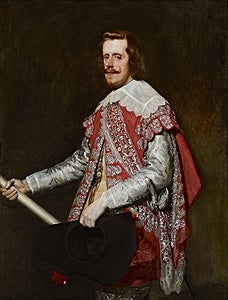The King at War: Velázquez's Portrait of Philip IV
October 26, 2010, through January 23, 2011
History and Function
| |
 |
|
|
| |
Diego Rodr’guez de Silva y Velázquez (1599–1660), King Philip IV of Spain,1644, oil on canvas, 51 1/8 x 39 1/8 inches, The Frick Collection, New York |
|
|
Diego Rodríguez de Silva y Velázquez (1599–1660) spent most of his career working for Philip IV as his official painter and also served in other capacities related to court etiquette and the king’s public image. In the spring of 1644 Velázquez accompanied king and court on an expedition to subdue the province of Catalonia, which had rebelled four years earlier with the support of the French. It was then that he painted this portrait of Philip IV.
Instead of the usual somber black court dress, Velázquez here represented the king wearing an eye-catching crimson sobreveste adorned with bands of glimmering brocade that match the sash to which his sword is fastened. These silver passages are rendered in unusually quick, free, and confi dent strokes of lavender-gray, neutral gray, and white. A white valona collar falls over the king’s shoulders. In his right hand he holds a general’s baton, while in his left he grasps a black triangular montera adorned with a red plume. Although the Spanish army did not have standard uniforms at the time, many soldiers would have worn clothes that were similar in cut but made of cheaper materials, and the military character of the king’s attire would have been evident to seventeenth-century observers. Nonetheless, this is an unusual choice of iconography, especially considering that in the campaign Philip fought his own subjects to reassert his sovereignty.
On 10 August 1644 a religious feast was held in Madrid to celebrate the king’s success in conquering the city of Lérida from the rebels. The event was organized by a community of monks who had been exiled from Catalonia because of their support for the king. Velázquez’s royal portrait was solemnly displayed inside the largest parish church of Madrid beneath a gold-embroidered canopy, its rich presentation stressing the fact that it stood as a surrogate for the king. One of the king’s preachers, José Laynez, delivered a sermon in which he explained aspects of the painting to his listeners to convey a specifi c political image of the king. Fortunately, the text of the sermon was later printed, and several copies have survived.
Just as the portrait by Velázquez was an important visual focus during the sermon, the printed text was accompanied by an engraved likeness of Philip IV, in which he is portrayed as conquering war and violence (symbolized by the weapons beneath him) and crowned by allegories of Religion and Faith. The points made visually in the engraving were expressed verbally in the sermon. Philip’s achievements were minimized, and his victory was interpreted as divine will. The king was characterized as a forgiving father, rather than a vanquishing warrior; conversely, the Catalan rebels were presented as repentant sinners, rather than defeated enemies. These ideas make it easier to understand the military iconography of the painting, and its unheroic, almost humble presentation of the king. Velázquez created an image that accommodates these messages perfectly. The portrait’s dark background, vibrant colors, and dazzling highlights were also particularly suitable for a painting made to be shown in a dimly lit church interior.
The exhibition is made possible by The Andrew W. Mellon Foundation |


